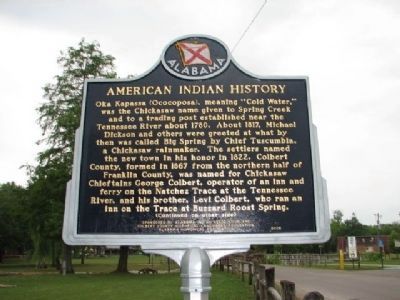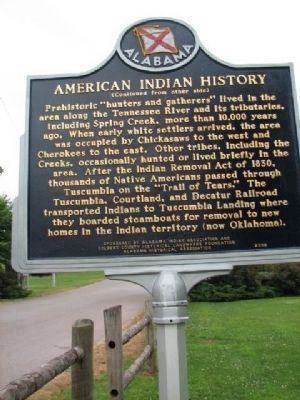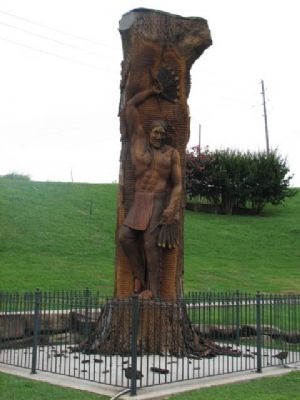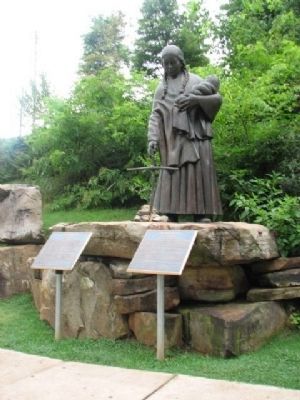Tuscumbia in Colbert County, Alabama — The American South (East South Central)
American Indian History
Side 1
Oka Kapassa (Ococoposa), meaning "Cold Water", was the Chickasaw name given to Spring Creek and to a trading post established near the Tennessee River about 1780. About 1817, Michael Dickerson and others were greeted at what by then was called Big Spring by Chief Tuscumbia, a Chickasaw rainmaker. The settlers named the new town in his honor in 1822. Colbert County, formed in 1867 from the Northern half of Franklin County, was named for Chickasaw Chieftains George Colbert, operator of an inn and ferry on the Natchez Trace at the Tennessee River, and his brother Levi Colbert, who ran an inn on the Trace at Buzzard Roost Spring.
(Continued on other side)
Side 2
(Continued from other side)
Prehistoric "hunters and gatherers" lived in the area along the Tennessee River and its tributaries, including Spring Creek, more than 10,000 years ago. When early white settlers arrived, the area was occupied by Chickasaws to the west and Cherokees to the east. Other tribes, including the Creeks, occasionally hunted or lived briefly in the area. After the Indian Removal Act of 1830, thousands of Native Americans passed through Tuscumbia on the "Trail of Tears." The Tuscumbia, Courtland, and Decatur Railroad transported Indians to Tuscumbia Landing where they boarded steamboats for removal to new homes in the Indian Territory (now Oklahoma).
Erected by Sponsored by Colbert County Historical Landmark Foundation and Cemetery Restoration Alabama Historical Association.
Topics and series. This historical marker is listed in these topic lists: Native Americans • Settlements & Settlers. In addition, it is included in the Alabama Historical Association, and the Trail of Tears series lists. A significant historical year for this entry is 1780.
Location. 34° 43.802′ N, 87° 42.303′ W. Marker is in Tuscumbia, Alabama, in Colbert County. S. Water Street at entrance to Big Spring Park. Touch for map. Marker is in this post office area: Tuscumbia AL 35674, United States of America. Touch for directions.
Other nearby markers. At least 8 other markers are within walking distance of this marker. U. S. Army M60A3 Main Battle Tank (within shouting distance of this marker); Tuscumbia Big Spring (about 400 feet away, measured in a direct line); Petrified Conifer Tree / Petrified Lycopod Tree Stump (about 500 feet away); Cold Water Falls (about 600 feet away); History of Tuscumbia, Alabama (about 600 feet away); Sacred Tears (about 700 feet away); Jackson's Military Road (approx. 0.2 miles away); Tuscumbia Railway First Railroad west of Alleghenies (approx. 0.2 miles away). Touch for a list and map of all markers in Tuscumbia.
Credits. This page was last revised on June 16, 2016. It was originally submitted on March 13, 2010, by Sandra Hughes Tidwell of Killen, Alabama, USA. This page has been viewed 2,711 times since then and 83 times this year. Last updated on May 18, 2015, by J. Makali Bruton of Accra, Ghana. Photos: 1, 2, 3, 4. submitted on March 13, 2010, by Sandra Hughes Tidwell of Killen, Alabama, USA. • Bernard Fisher was the editor who published this page.



